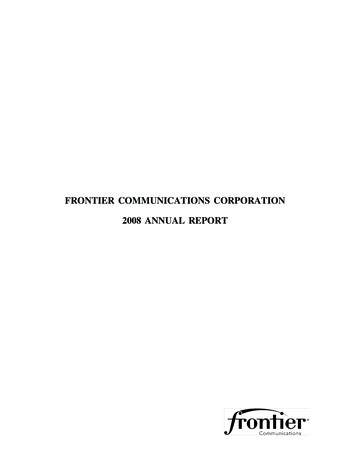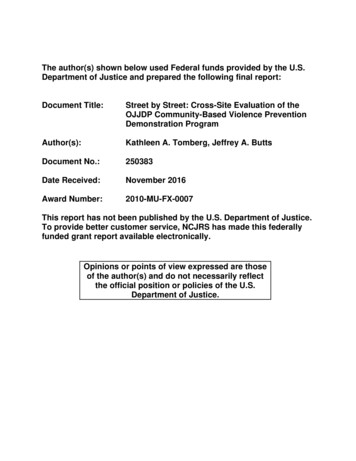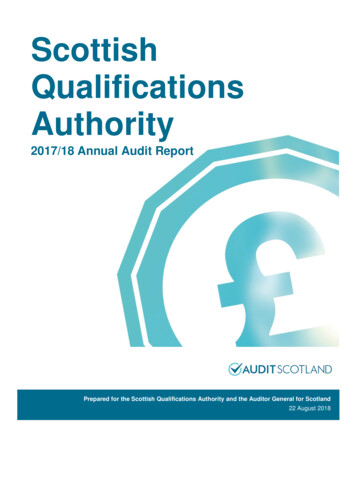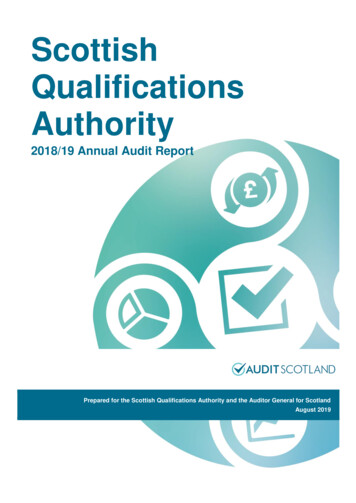
Transcription
Office of the Comptroller of the CurrencyANNUAL REPORT FY 2008The seal depicted on the front cover dates to 1863. It was designed underthe direction of the first Comptroller of the Currency, Hugh McCulloch,chosen by President Abraham Lincoln and Secretary of the TreasurySalmon P. Chase. The OCC marked its 145th anniversary in 2008.Comptroller of the CurrencyAdministrator of National BanksUS Department of the TreasuryOffice of the Comptroller of the CurrencyANNUAL REPORTFiscal Year 2008
TOCC VISIONhe Office of the Comptroller of the Currency (OCC)seeks to assure a banking system in which nationalbanks soundly manage their risks, comply withapplicable laws, compete effectively with other providers offinancial services, offer products and services that meet theneeds of customers, and provide fair access to financialservices and fair treatment of their customers.
ContentsComptroller’s Viewpoint . . . . . . . . . . . . . . . . . . . . . . . . . . . . . . . . . . . . . 1Introduction . . . . . . . . . . . . . . . . . . . . . . . . . . . . . . . . . . . . . . . . . . . . . . . 5Section One: State of the National Banking System . . . . . . . . . . . . . . . 7Section Two: State of OCC Supervision . . . . . . . . . . . . . . . . . . . . . . . . 11Section Three: Organizational Highlights . . . . . . . . . . . . . . . . . . . . . . . 33Section Four: Financial Management Discussion and Analysis . . . . . 45List of Acronyms . . . . . . . . . . . . . . . . . . . . . . . . . . . . . . . . . . . . . . . . . . 80Index . . . . . . . . . . . . . . . . . . . . . . . . . . . . . . . . . . . . . . . . . . . . . . . . . . . . 81Inside Front Cover: OCC VisionInside Back Cover: OCC History and TraditionsDecember 2008i
OCC Offices in the Continental United StatesSeattleFargo DuluthAlexandriaBillingsMinneapolisSioux CitySalt Lake CityLos AngelesOmahaChampaignIndianapolisCincinnatiKansas CityCharlestonSalinaLouisvilleSt. rqueWilkes-BarreNew YorkShort HillsEdisonCleveland PittsburghPhiladelphiaColumbusWashington, DCDetroitChicagoPeoriaGrand IslandDenverSanta AnaCarlsbadSan DiegoSyracuseBostonEau ClaireMilwaukeeSioux FallsSanFranciscoPortlandIron MountainOklahoma ittle RockAtlantaBirminghamLubbockFort WorthJacksonDallasLongviewJacksonvilleAustinSan AntonioHoustonNew OrleansTampaCorpusChristiMiamiFigure 1: Statistical Profile ofthe OCC’s Fiscal Year 2008Number of Total 3,122EmployeesNumber of National 2,079Bank ExaminersNumber of Safety 1,2661and SoundnessExaminations ConductedNumber of 630Specialty ExaminationsConductedNumber of 48Consumer AssistancePersonnelNumber of Written 41,656Consumer ComplaintsProcessedTotal Revenue 736.1 million2Percentage of Revenue 96.1Derived from AssessmentsLarge and midsize national banks receive continuoussupervision.1Ninety-six percent of OCC revenue is derived fromassessments.2iiFigure 2: Statistical Profile ofthe National Banking SystemNumber of National Banks 1,678Percentage of Total 20Commercial BanksNumber of Uninsured 73National Trust CompaniesNumber of Federal 49Branches of Foreign BanksAssets of National 8.3 trillionBanks (Excluding FederalBranches of Foreign Banks)Percentage of Total U.S. 62Commercial BankingAssetsTotal Insured Deposits 4.886 trillionNumber of Employees of 1,247,143National BanksCommunity Development 3.7 billionInvestment AuthoritySource: OCC, 2008.Off ice of the Comptroller of the Currency Fiscal Year 2008 Annual Report
Comptroller’s ViewpointFor the financial system, both here andabroad, the fiscal year that ended September30 was without question the mostextraordinary of my lifetime. In fact, when I lookback on all that has happened since we publishedour last annual report, I am struck by the sheernumber of events involving severe credit and marketstress, any one of which could have been the mostserious financial problem of the year in the muchquieter period before 2007.Just naming the worst of them is both telling andexhausting. The first annual decline in nationwidehouse prices. Record foreclosure levels. Brutallosses on subprime loans. The near shutdown ofinterbank lending markets and the liquidity freezefor asset-backed commercial paper and structuredinvestment vehicles, or SIVs. The governmenttakeover of Fannie Mae and Freddie Mac. Thefailure of Lehman Brothers, IndyMac, and WaMu.The distress sales of Countrywide to Bank ofAmerica, Bear Stearns to JPMorgan Chase, andWachovia to Wells Fargo. The administration planto use 700 billion to unfreeze the credit markets.Could all of these major financial events havereally happened in just one year? The answer, ofcourse, is yes. In fact, many of the most dramatic ofthem happened in just over a month. In reflectingon this “100-year flood,” let me provide a fewobservations from the perspective of the OCC.First, national banks took important stepsto strengthen their positions. Large banks thatexperienced difficulties responded by aggressivelyraising capital to shore up their balance sheets,attracting well over 100 billion. As a result,virtually all national banks continued to satisfy thedefinition of “well capitalized” on September 30.Banks of all sizes have rapidly increased loan lossreserves to address the spike in troubled loans—in some cases to unprecedented levels. Whilefiscal 2008 was a difficult year with many tensemoments, we should not lose sight of these verytangible positive signs amid the steady drumbeat ofnegative news.December 2008Second, despite theunprecedented nature of theseevents, the OCC anticipatedmany of them before theyoccurred and dealt with themonce they arrived. We soundedearly public warnings inguidance and speeches aboutrisk layering, payment shock,and declining underwritingstandards for “payment option” mortgages and homeequity lending. Our higher standards for subprimemortgage underwriting kept most of that lending outof national banks. The subprime loans that nationalbanks did make were generally of higher qualitythan those originated elsewhere.For commercial real estate (CRE) concentrationsin community banks, we conducted rigoroushorizontal reviews in each of the four OCC districtsstarting in 2004; we pushed hard for the CREguidance subsequently issued in 2006 over industryopposition; and we delivered our messages againand again in speeches, outreach meetings, andexaminations all over the country.Our annual underwriting surveys repeatedlyspotlighted the trend of declining underwritingstandards, particularly with respect to leveragedloans. We also recognized early on that communitybank failures would accelerate in 2008; wetalked about that publicly; and we planned for it.Distressed institutions—large and small—havedemanded far more attention and supervision thannormal, and at times, tensions have run high. OCCexaminers stepped up to each unfolding event withspeed, maximum effort, and teamwork. We neededthe best from our examiners, and they delivered. Itis no accident that banks have gotten more realisticabout recognizing delinquency and loss; raisedsignificant amounts of capital when they could;aggressively built loan loss reserves and agreed totangible actions that would fundamentally improvetheir risk management. It is an examiner’s job toget banks to take these sometimes painful steps to1
Members of theExecutive CommitteeThomas R. BloomSenior DeputyComptroller forManagementand ChiefFinancial OfficerJennifer C. KellySenior DeputyComptroller forMidsize/CommunityBank SupervisionJohn C. DuganComptroller of the CurrencyMark LevonianSenior DeputyComptroller forEconomicsimprove their safety and soundness, but it has notalways been easy.The OCC has also initiated new data gatheringto help address the recent problems. Perhaps thebest example is our Mortgage Metrics project. Anunprecedented effort accomplished in record time,this project gathered loan level data on over 40percent of the mortgages serviced in the UnitedStates. Importantly, the data are both standardizedand validated. We now know much more than weonce did about trends in delinquency, modification,and foreclosure with respect to prime, subprime,and Alt-A mortgages, and we have begun touse that data in a variety of ways to support oursupervision and our efforts to mitigate the impact ofthe economic crisis on homeowners. We have alsobegun to develop similar metrics for home equityand credit card lending, and we think that data, too,will prove very important to our supervision and ourconsumer protection initiatives.But there were some problems we clearly did notanticipate, and we need to learn some lessons andmake some improvements going forward. Here are afew that stand out. Liquidity. A number of banks were not as preparedto deal with liquidity strains as they should have2Timothy W. LongSenior DeputyComptroller andChief NationalBank ExaminerBajinder N. PaulChief InformationOfficerbeen, thinking that their access to funding, evenin times of stress, would be much better than itproved to be. I think the regulatory communityhad that same misimpression, and a number ofus have concluded that our liquidity metrics werenot sufficiently robust. We have been workingwith banks all over the country to improvetheir liquidity positions. In addition, the BaselCommittee issued a very thoughtful paper onliquidity risk management, and we have spent aconsiderable amount of time developing a bettertemplate for gathering data to measure liquidityrisk. I believe these efforts will produce realimprovement over time. Risk management for complex financialinstruments. Collateralized debt obligations(CDOs) backed by subprime mortgages werethe prime example of the need for better effortshere. Despite the inherent risk of the underlyingcollateral, the industry and regulators were lulledinto a false sense of security by the triple-Aratings given to the super-senior tranches of thesesecurities. Some of the exposure was masked inoff-balance-sheet vehicles in ways that cloudedthe full extent of exposure. Indeed, some seniorbank management thought they had avoidedOff ice of the Comptroller of the Currency Fiscal Year 2008 Annual Report
this: some concentrations can be so largethat even the best risk management willfall short when an economic storm focuseson that same asset class. While the juryis very much still out, and the subject iscontroversial, regulators and policymakers inthe future may very well need to revisit theissue of appropriate levels of concentration.A major concern I have going forward isthe pressure to lower underwriting standardsfor loans that are sold to others as opposedto those held in portfolio. Some banksapplied different underwriting standards forloans sold to Wall Street securitizers forfurther sale to investors, while the standardswere more rigorous for loans that bankskept on their books. The same was truefor leveraged loans originated by our veryJulie L. WilliamsJohn G. WalshDouglas W. RoederChief of Staff andFirst Senior DeputySenior Deputylargest banks.Public AffairsComptroller andComptrollerIn both cases, when examiners beganChief Counselfor Large Banktocriticizethe lower standards for loansSupervisionthat were sold, we often heard the sametwo arguments in response. First, somesubprime risk by deliberately choosing to avoidargued that weaker underwriting standardsoriginating such loans in the bank—only to findshould not matter if the risk leaves the bank whenout after the fact that their investment banks hadthe loan is sold to a willing buyer who understandspurchased subprime loans elsewhere to structurethe increased risk. And second, some claimedthem into CDOs. And when the market seizedthat if banks were forced to raise their standardsup, some banks that structured the CDOs for saleabove the level required by the market, they wouldto third parties wound up holding large positionslose business to others who did not have to raisethat no one wanted to buy. That resulted in hugetheir standards.concentrations, which in turn led to huge losses.Events of the last year have revealed theThere was too much reliance on triple-A ratings,fundamental flaw in those arguments. Whennot enough transparency and risk aggregation, andfunding markets lock up, banks can get stucktoo much tolerance for concentrations.holding a large pipeline of the loans they plannedto sell, and the weak underwriting can translate Risk concentrations in commercial real estate.into huge writedowns and losses. That is whatThe OCC and the banks we supervise did ahappened in the leveraged loan market, and it istremendous amount to anticipate and addressalso what happened to a number of banks withpotential issues before they turned into problems,large mortgage warehouses.and we have been especially proactive in squarelySo the painful lesson learned is that banks needaddressing these problems as they have emerged.to underwrite loans for sale as they would for loansBut I have been troubled in looking at the banksheld in portfolio, and we need to hold banks to thatthat have failed thus far—both national and statestandard or something very close to it. That is easybanks—by some toxic combinations of realenough to say now, when the loan sale market isestate concentrations, rapid growth, extremelyclosed, but it will be much harder to put in practicehigh levels of brokered deposits, and out-of-areawhen the market reopens and banks start making thelending. In the future, I think we will need to dosame arguments once again. Holding the line willmore to check these combinations before theyclearly be one of our challenges for the future.cause unmanageable problems. And let me addDecember 2008Comptroller’s Viewpoint3
And now let me turn to my final observationabout the recent credit turmoil, which is this: it is along way from over. The administration’s plan toinvest capital in, and guarantee the debt to, financialinstitutions has helped stabilize the market. Butas we approach the end of 2008, the economy hasplainly weakened. At least in the near term, allof this is likely to mean more credit losses; moreprovisions to loan loss reserves; squeezed profits;strains on capital; and, in some cases, more bankfailures.Facing all of this, I think it is critical that theOCC continues to strive for the kind of balancedprofessional judgment that we have shown thus far.We have to be careful to be forthright in addressingproblems as we see them and leaning on bankmanagement to do exactly the same. But we haveto be equally careful not to overreact and makeproblems worse by acting too precipitously or beingmore stringent than necessary.It is also important that in our focus on credit andliquidity issues we not lose sight of our complianceand consumer protection responsibilities. We knowthat compliance lapses can do significant damageto a bank’s reputation—the kind of damage thatcan take years to repair and that diverts time andattention away from the business of running thebank. I have asked our examiners to see to it that indealing with the industry’s safety and soundness,we do not allow significant compliance problems todevelop in their place.As we attempt to strike that balance in oursupervision, it is all but certain that we will seemore national bank failures, and some will ask ifwe should not have done more to prevent one bankfailure or another, or if we should have movedsooner to close a troubled bank. These are importantquestions. But it is just wrong to argue that any bankthat fails and costs the deposit insurance fund moneycould have been closed sooner at less cost. It is alsowrong to suggest that any bank that fails means thatsupervisors did not do their jobs.While either assertion could be true with respectto a specific bank, it is just as possible—and frankly,more likely—that neither is true with respect to aparticular failure. The fact is, banks take risks when4they make loans, as they should, and sometimesthey fail because the risks prove larger than theyreasonably anticipated; or the local economy sufferssevere stress, devastating businesses to which thebanks lend; or extraordinary events like the ones wehave seen in the last year put strains on banks thatjust could not be reasonably anticipated.When banks like these suffer large losses,examiners have to make hard judgments aboutviability. Should the bank be closed immediatelywith a certain loss to the deposit insurance fund? Ordoes it have a reasonable prospect of raising capitalor being sold, preventing any loss to the fund? Thelatter option, of course, may take a little time tofind out. Sometimes that time produces a positiveresult that avoids failure and loss altogether, andsometimes it does not. But even when it does not, itis not at all clear that the ultimate loss to the fund isgreater than it would have been had the bank beenclosed earlier. In fact, that should not be the case ifthe bank is tightly regulated during the process toavoid excessive risk-taking, which is exactly whatwe do with a bank in these circumstances.The bottom line is this: bank closing is anart, not a science. Sometimes it is better to do itfast, and sometimes it is much better to take thetime, in controlled circumstances, to try to finda solution that avoids loss to the fund. Our mostseasoned examiners make these kinds of viabilitydeterminations, working closely with the FederalDeposit Insurance Corporation (FDIC), and wethink this is by far the best approach to least-costresolution.I am proud of the hard work and dedicationOCC staff has shown in meeting the extraordinarychallenges of the last year. One of my greatcomforts in serving as Comptroller is knowingthat I can rely on such a strong corps of talented,dedicated people who are doing all they can to helpensure the safety and soundness of our nationalbanks. The national banking system is the backboneof a strong U.S. economy, and we at the OCC willcontinue to work hard to ensure that it remains safeand sound, and capable of supporting Americanconsumers and businesses.Fiscal Year 2008 Annual Report
IntroductionAgainst the backdrop of one of the mosttumultuous years in U.S. financial history,the OCC’s Fiscal Year 2008 Annual Reporthighlights how the OCC performs its primarymission of examining, supervising, and charteringnational banks. In times like these, the agency isespecially sensitive to how financial institutionstouch the lives of the individual Americans who,as employees, shareholders, and customers, havea direct stake in their safety and soundness. TheOCC’s ultimate responsibility goes beyond thebanks we supervise to the broader public interest weserve.Processes and people are central to theaccomplishment of the OCC’s mission. The OCCroutinely provides professional and independentbank supervision, and our people are widelyrecognized as exceptionally competent at whatthey do. We provide advanced training forexaminers; integrate new technologies into banksupervision; develop sophisticated risk models toinform supervisory strategy and practice; placeresident examining teams in our largest, mostcomplex institutions; maintain separate supervisoryapproaches for midsize and community banks; offeran appellate process for national bankers; ensure thatexaminers have specialized expertise in such areasas compliance, bank technology, capital markets,mortgage banking, and operational risk; and providenational bank customers a state-of-the-art means ofresolving complaints.The OCC’s risk-based approach to supervisionprovides a framework for identifying banks withelevated risk, assessing the risk those institutionsDecember 2008might pose to the national banking system, anddeploying supervisory resources accordingly. Riskbased supervision proved especially important giventhe increased number of at-risk institutions in fiscalyear 2008.Despite the heavy focus on direct examinationand supervision, the fiscal year saw a large numberof policy initiatives. The OCC continues to workwith legislators and other regulators to promoteregulatory efficiency and enhance consumerprotection, fair lending, and equal access to credit.Recognizing the importance of these aspects ofsupervision and the danger that market eventsmight overshadow these issues, Comptroller Dugancautioned that “market disruption could so dominatethe attention of bankers and regulators that we losefocus on other still-important priorities. We simplycannot allow that to happen.”Responding to the challenges of the economyrequires dedicated people with the right skills,motivation, and experience. This annual reportspotlights OCC team members who representsome of the many diverse professions that mustbe integrated properly for the OCC to succeed—examiners working in national banks and in policypositions; attorneys who help write, interpret, andenforce laws and regulations; economists whoprovide data and analytical tools; managementspecialists who ensure efficient use of our humanand material resources; information technologyexperts; community affairs officers; and manyothers, who, together, bring diverse perspectives tothe OCC. This range of expertise, developed over145 years, enables us to maintain high standards forbank supervision in good times and bad.Introduction5
6Fiscal Year 2008 Annual Report
Section One State of the National Banking SystemOCC Supervisory Efforts in Face of 2008 Market TurmoilBefore the damage spread throughout theU.S. financial system, OCC examiners werefocused on the emerging fault lines in thecredit markets. In 2005, for example, at a time whenbank profitability was strong and house prices werestill appreciating, the agency instructed examiners toaddress the risk of loan products with the potentialfor payment shock, such as hybrid mortgages thatstart with low monthly payments followed bypayments that are much higher. Although nationalbanks largely avoided subprime lending, nonbanklenders made large numbers of these loans, andthe consequences eventually spilled over into thebroader credit markets.By 2008, as Comptroller Dugan noted incongressional testimony, the national bankingsystem was being tested by two powerful andrelated forces that were exerting pressure on banksof all sizes in many parts of the country. “One isthe large and unprecedented series of credit marketdisruptions, still unfolding, that was precipitated bydeclining house prices and severe problems withsubprime mortgages,” he told the Senate BankingCommittee. The other was the slowdown in theeconomy, which had begun to affect credit qualityadversely for a number of asset classes.“The combination of these forces has strainedthe resources of many of the national banks weregulate,” Mr. Dugan said at that hearing onMarch 4, 2008.While the national banking system remainsfundamentally sound, the effects of these complexmarket dislocations are still working throughthe financial system. At the height of the marketturmoil, banks showed increasing reluctance to lendto each other out of concern over credit quality anda desire to maintain liquidity in the face of marketuncertainty. The contraction of market liquidityrequired some large national banks to fund and holdadditional assets on their balance sheets. The rapiddeterioration in credit quality of subprime mortgagesled to substantial write-downs in certain structuredinvestment products.Figure 3: Assets, Total Loans, and Equity from 1972 to 2008National Banks ,000Equity1,0000072 74 76 78 80 82 84 86 88 90 92 94 96 98 00 02 04 06 08Source: Integrated Banking Information System (OCC)December 2008Note: 2008 data as of June 30, 2008.All other data as of year-end.7
The downturn in housing and the broadereconomy affected national banks’ loan portfoliosadversely, increasing the level of nonperforming andpast-due loans. Noncurrent loans—the percentage ofbank loans that are 90 days or more past due and onnonaccrual—rose to 1.80 percent at the end of June2008, up from 0.86 percent a year earlier, as Figure4 shows, and then rose again, to 2.19 at the endof September 2008. Even at that level, noncurrentloans were low by historic standards. Deteriorationin loans tied to the real estate sector, however, wasmore pronounced. Losses from housing loans rose tonew highs, and losses on other retail credits were upsharply. Credit stress was complicated by elevatedliquidity risk and, in the latter part of the year,by heightened concern about the safety of retaildeposits in the wake of publicized bank failures. Allof these events were reflected in lower earnings forthe national banking industry.Figure 4: Noncurrent Loans from 1984 to 2008National BanksNoncurrent loansPercent of total 921992199619962000200020042004200820080.0Source: OCC call reports; annual data for 1984-2007 and data for 2008 are for return averageNational bank net income in 2008 declinedto one-third of its level a year earlier. Nationalbanks recorded income of 6.9 billion in 2008’ssecond quarter, down from 21.5 billion a yearearlier. Return on equity, a key measure of bankprofitability, was 3.5 percent in the second quarterof 2008 versus 12.8 percent a year earlier. As Figure5 shows, 2008 return on equity year-to-date isaveraging 4.4 percent, substantially below the levelseen before the market turmoil began.Figure 5: Return on Equity from 1984 to 2008National BanksReturn on 2199619962000200020042004020082008-2-2Source: OCC call reports; annual data for 1984-2007 and data for 2008 are for return average8Fiscal Year 2008 Annual Report
Over the last year, weak noninterest incomeand higher provisions were the main drags onearnings. Large banks benefited from improvedprofit margins, while the margins of smaller banksdeteriorated. Despite poor earnings, banks were ableto increase capital and reserves over 2007 levels.Figure 6: Loss Provisions to Charge-OffsNational BanksPercent250230.99185.2020015010050500 072 74 76 78 80 82 84 86 88 90 92 94 96 98 00 02 04 06 08Source:OCC IntegratedBankingSystemSource: IntegratedBanking InformationSystem Information(OCC)Note:2008 data as of June 30, 2008.All other data as of year-end.Note: 2008 data as of June 30, 2008. All other data as of year-end.National banks were generally able to absorb thefinancial shocks for a number of reasons. The first,and most important, is that banks, having enteredthis period in overall good health, had the earningsand capital to weather market downturns. Capitallevels well in excess of regulatory minimums gavebanks the flexibility to absorb sizable quantitiesof assets on their balance sheets when liquidity inthe credit and capital markets became constrained.Throughout the year, banks took steps to furtherstrengthen their balance sheets by increasing loanloss reserves, reducing dividends, and issuingcapital in both public and private offerings. Theirability to raise capital reflected investors’ beliefin the underlying long-term viability of thesefranchises. Nonetheless, should credit performanceworsen, additional loan loss reserves and capitalmay be required.December 2008National banks, especially larger ones, benefitedfrom diversified lines of business and fundingsources. For example, although fees from loan sales,securitizations, and trading were adversely affectedby the downturn in housing, other fee incomesources remained. Indeed, throughout the year, thenational banking system has generally been a sourceof strength for the financial sector, providing creditand liquidity to both the retail and commercialsectors, and absorbing companies and product linesthat faltered or failed under the strains of marketdislocation.While the vast majority of national banks havehad the financial capacity and management skillsto weather the challenges of the past year, a fewhave not. In these cases, the OCC’s goal has beento effect early and least-cost resolution of the bankso as to minimize losses to depositors and the FDICinsurance fund. During fiscal year 2008, the OCCappointed the FDIC as receiver in five bank failures.Section One State of the National Banking System9
10Fiscal Year 2008 Annual Report
Section Two State of OCC SupervisionBank Supervision in a Time of Challenge . . . . . . . . . . . . . . . 11Community Bank Supervision: Assistant Deputy ComptrollersMobilize OCC Resources To Protect Safety and Soundness . . . . . . . . . . . . . . 12Large Bank Supervision: Examiners-in-Charge of the MostComplex Financial Institutions. . . . . . . . . . . . . . . . . . . . . . . . . . . . . . 13OCC Responds to Rising Tide of Mortgage Foreclosures . . . . . . . . . . . . . . . . 16OCC Supervises Surge in International Activities by National Banks . . . . . . . . . 20Functional Specialists Bring Technical Expertise to Bank Supervision. . . . . . . . . 22Economic and Financial Analysis Supports the OCC’s Work. . . . . . . . . . . . . . 23New Mortgage Metrics Report Increases Visibility of Mortgage Loan Data. . . . . . 24Risk Analysis Division Bolsters OCC Supervision. . . . . . . . . . . . . . . . . . . . 25Compliance Policy Helps Banks and Examiners Stayon Top of Changing Regulations . . . . . . . . . . . . . . . . . . . . . . . . . . . . . 26Fair Lending, Fair Treatment, and Fair Access Are Key Priorities . . . . . . . . . . . 26Attorney Provides Counsel, Expertise to the Supervisory Team . . . . . . . . . . . . 27OCC Presses Other Regulators for a Unified and Simpler Complaint Process . . . . . 28OCC Steps Up Efforts To Support Mino
house prices. Record foreclosure levels. Brutal losses on subprime loans. The near shutdown of interbank lending markets and the liquidity freeze for asset-backed commercial paper and structured investment vehicles, or SIVs. The government takeover of Fannie Mae and Freddie Mac. The failure of Lehman Brothers, IndyMac, and WaMu.










